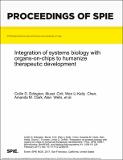Integration of systems biology with organs-on-chips to humanize therapeutic development
Author(s)
Clark, Amanda M.; Wells, Alan; Edington, Collin D; Cirit, Murat; Chen, Wen Li; Trumper, David L; Griffith, Linda G; ... Show more Show less
Download1006113.pdf (257.1Kb)
PUBLISHER_POLICY
Publisher Policy
Article is made available in accordance with the publisher's policy and may be subject to US copyright law. Please refer to the publisher's site for terms of use.
Terms of use
Metadata
Show full item recordAbstract
"Mice are not little people" - a refrain becoming louder as the gaps between animal models and human disease become more apparent. At the same time, three emerging approaches are headed toward integration: powerful systems biology analysis of cell-cell and intracellular signaling networks in patient-derived samples; 3D tissue engineered models of human organ systems, often made from stem cells; and micro-fluidic and meso-fluidic devices that enable living systems to be sustained, perturbed and analyzed for weeks in culture. Integration of these rapidly moving fields has the potential to revolutionize development of therapeutics for complex, chronic diseases, including those that have weak genetic bases and substantial contributions from gene-environment interactions. Technical challenges in modeling complex diseases with "organs on chips" approaches include the need for relatively large tissue masses and organ-organ cross talk to capture systemic effects, such that current microfluidic formats often fail to capture the required scale and complexity for interconnected systems. These constraints drive development of new strategies for designing in vitro models, including perfusing organ models, as well as "mesofluidic" pumping and circulation in platforms connecting several organ systems, to achieve the appropriate physiological relevance. Keywords: organs-on-chips; 3D liver culture; perfusion; drug development; inflammation; organ crosstalk; tissue chip; intestine
Date issued
2017-02Department
Massachusetts Institute of Technology. Department of Mechanical EngineeringJournal
Microfluidics, BioMEMS, and Medical Microsystems XV
Publisher
SPIE
Citation
Edington, Collin D. et al. “Integration of Systems Biology with Organs-on-Chips to Humanize Therapeutic Development.” Edited by Bonnie L. Gray and Holger Becker. Microfluidics, BioMEMS, and Medical Microsystems XV, January - February 2017, San Francisco, California, USA, February 2017 © 2017 SPIE
Version: Final published version
ISSN
0277-786X
1996-756X